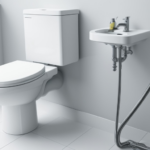Synthetic turf features porous backing material that lets rainwater drain through to the ground. Installers also design drainage systems to guide the water away from the turf and prevent flooding.
Without a proper drainage system, water can get trapped beneath the turf, causing unevenness, instability, water puddles, mold, and mildew. Here’s more information about the artificial turf drainage system, including the different components used to facilitate drainage:
Turf Backing Drainage
Artificial lawn drainage systems feature a permeable backing material to let water drain from the turf’s surface to the ground below. The backing material can be hole-punched or fully permeable. Hole-punched backing features drainage holes punched through the turf’s backing at equal distances.
These holes drain water during heavy rains and are the common technique used to prevent artificial turf from flooding. Fully permeable backing features a porous design that drains water all across the turf. This backing is more effective at draining water from your turf and is a great choice for pet daycare centers and areas that require enhanced drainage.
Turf Subbase Drainage
Ground preparation is the first step of artificial grass installation. The installers check the soil drainage, level the area, and create slight gradients to help with drainage. Experienced professionals can create unnoticeable slopes that drain water away from the lawn or your property.
The professionals compact the subbase to provide a solid surface for installation, but it is kept porous to allow water to drain through. If the subbase is too compact and impermeable, water may be trapped beneath the turf, leading to puddles and flooding. Turfs used for landscaping, playgrounds, and outdoor sports fields usually feature gravel and soil subbases.
Air Drains and Turf Trays
Rooftop turfs and other hard-surface installations that don’t have porous ground beneath the artificial grass require advanced drainage systems. Common options for hard-surface turfs include air drains and turf trays. Air drains use small trays made of recycled materials to lift the turf and create a space between the surface and the backing. This space allows water to flow away from the turf.
Synthetic turf trays are grid-like pieces joined to create a flat porous underlayment. The trays are used together with adjustable pedestals for leveling. Like air drains, the trays separate the turf from the compact, non-porous surface.
Automatic Turf Flushing Systems
Pet daycares and high-traffic commercial rooftop turfs may feature automatic flushing systems installed beneath the synthetic grass. These systems use a hidden cleaning unit that periodically flushes and drains the turf to keep it dry. Automatic flushing systems also require a raised air grid, trench pipes, and a slightly sloped impermeable surface.
Manual systems use a hose connected to a flushing port that runs water throughout each zone. Semi-automated systems use controlled valves and charged water lines with pipes running each quadrant. Fully automated systems use sprinklers, porous pipes, and charged water lines.
Gravel Filtration Systems
A gravel filtration system is an alternative to automatic flushing systems used in high-traffic commercial areas and pet-friendly turfs. This system doesn’t have a flushing mechanism but uses a drain core layer underneath the synthetic turf. The system has two layers of large rocks at the bottom and finer gravel at the top.
Turf suppliers sometimes add deodorizers to the top layer to help reduce odor from pet urine and waste. Professionals place a gravel layer on top of the impermeable subbase and provide a drain outlet that allows water to flow away from the turf. Water seeps through the backing into the gravel and out through the drain hole at the bottom.
Install Premium Quality Artificial Turf Today
Synthetic turf offers a low-maintenance option for landscapers, homeowners, and commercial outlets. The turf doesn’t require watering, herbicides, fertilizer, mowing, sunlight, or pesticides. Artificial grass also retains its color throughout the year and can be used in outdoor and indoor applications. Contact a synthetic grass supplier today to find out more about artificial turf drainage systems and options.



